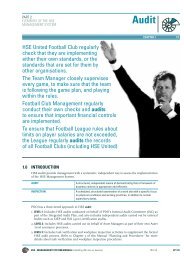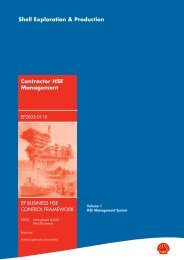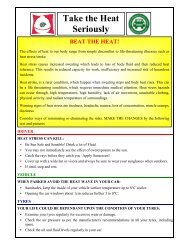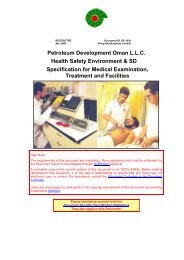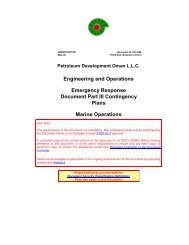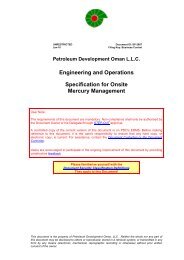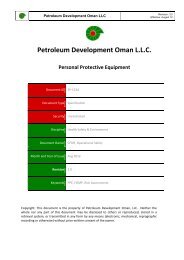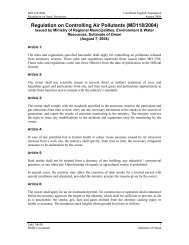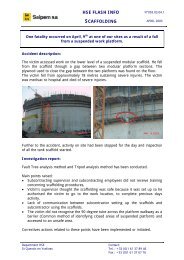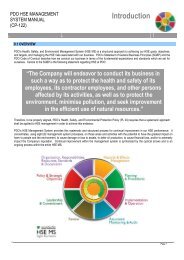HFE in New Facilities Projects - PDO
HFE in New Facilities Projects - PDO
HFE in New Facilities Projects - PDO
Create successful ePaper yourself
Turn your PDF publications into a flip-book with our unique Google optimized e-Paper software.
Human Factors Eng<strong>in</strong>eer<strong>in</strong>g (<strong>HFE</strong>)<br />
<strong>in</strong> <strong>New</strong> <strong>Facilities</strong> <strong>Projects</strong><br />
July 2003<br />
Policy and strategic objectives<br />
Organisation, responsibilities<br />
resources, standards, documents<br />
Hazards and Effects Management<br />
Plann<strong>in</strong>g and procedures<br />
Implementation<br />
Audit<br />
Management review<br />
Health, Safety and Environment HSE<br />
Shell Health, Safety and Environment Panel<br />
Corrective action<br />
Monitor<strong>in</strong>g<br />
Corrective action and improvement<br />
Corrective action and improvement<br />
b
Human Factors Eng<strong>in</strong>eer<strong>in</strong>g (<strong>HFE</strong>)<br />
<strong>in</strong> <strong>New</strong> <strong>Facilities</strong> <strong>Projects</strong><br />
The T companies belong<strong>in</strong>g to the Royal Dutch/Shell Group of companies are separate and dist<strong>in</strong>ct entities,<br />
but <strong>in</strong> this document the collective expressions “Shell” and “Group” are sometimes used for convenience<br />
<strong>in</strong> contexts where reference is made to the companies of the Royal Dutch/Shell Group <strong>in</strong> general. These<br />
expressions are also used where no useful purpose is served by identify<strong>in</strong>g the particular company or<br />
companies.<br />
This document is prepared by Shell Internationale Petroleum Maatschappij B.V. (SIPM) as a service under<br />
arrangements <strong>in</strong> existence with companies of the Royal Dutch/Shell Group; it is issued for the guidance of<br />
these companies and they may wish to consider us<strong>in</strong>g it <strong>in</strong> their operations. Other <strong>in</strong>terested parties may<br />
receive a copy of this document for their <strong>in</strong>formation. SIPM is not aware of any <strong>in</strong>accuracy or omission from<br />
this document and no responsibility is accepted by SIPM or by any person or company concerned with<br />
furnish<strong>in</strong>g <strong>in</strong>formation or data used <strong>in</strong> this document for the accuracy of any <strong>in</strong>formation or advice given <strong>in</strong><br />
the document or for any omission from the document or for any consequences whatsoever result<strong>in</strong>g directly<br />
or <strong>in</strong>directly from compliance with or adoption of guidance controlled <strong>in</strong> the document even if caused by a<br />
failure to exercise reasonable care.<br />
SHELL HEALTH, SAFETY AND ENVIRONMENT COMMITTEE<br />
The copyright of this document is vested <strong>in</strong> Shell Internationale Petroleum Maatschappij B.V.,<br />
The Hague, The Netherlands.<br />
All rights reserved.<br />
July 2003<br />
Human Factors Eng<strong>in</strong>eer<strong>in</strong>g (<strong>HFE</strong>) <strong>in</strong> <strong>New</strong> <strong>Facilities</strong> <strong>Projects</strong>, Issue 2.0, July 2003<br />
d
Document History<br />
Date Issue Reason for change Author Approval Signature<br />
December 1995 1.0 First Issue HSE<br />
July 2003 2.0 Second Issue HE/2<br />
The pr<strong>in</strong>ted version of this document is the controlled version. It is also available on the<br />
PXE Website: http://sww.shell.com/hse/group/hse/hse_publications/publications.htm<br />
Superseded issues of this document should be destroyed.<br />
e Human Factors Eng<strong>in</strong>eer<strong>in</strong>g (<strong>HFE</strong>) <strong>in</strong> <strong>New</strong> <strong>Facilities</strong> <strong>Projects</strong>, Issue 2.0, July 2003
Table of Contents<br />
Table of Contents<br />
1 Purpose 1<br />
2 Scope and Applicability 2<br />
3 Group Standard 3<br />
4 Management System 4<br />
4.1 Conduct a gap analysis on the exist<strong>in</strong>g project management procedure. 4<br />
4.2 Update project management procedures and assure competence. 4<br />
4.3 Implementation of Procedure HE.03.007 5<br />
5 References 6<br />
Human Factors Eng<strong>in</strong>eer<strong>in</strong>g (<strong>HFE</strong>) <strong>in</strong> <strong>New</strong> <strong>Facilities</strong> <strong>Projects</strong>, Issue 2.0, July 2003<br />
f
1<br />
Purpose<br />
Purpose<br />
There is signifi cant evidence that systems which adhere to the “human-centred design” philosophy<br />
dur<strong>in</strong>g early development often result <strong>in</strong> <strong>in</strong>creased productivity, enhanced quality of work, safer<br />
and more healthy work<strong>in</strong>g conditions, a reduction <strong>in</strong> support and tra<strong>in</strong><strong>in</strong>g costs, and improved user<br />
satisfaction (ref. 1). Although the human-mach<strong>in</strong>e <strong>in</strong>terface <strong>in</strong> process <strong>in</strong>dustry projects has always<br />
been considered to be an <strong>in</strong>tegral part of a sound eng<strong>in</strong>eer<strong>in</strong>g design, many misfi ts <strong>in</strong> operability,<br />
ma<strong>in</strong>ta<strong>in</strong>ability, system reliability and product design are still experienced dur<strong>in</strong>g the operational<br />
phase.<br />
<strong>HFE</strong> is an approach to system design focused on usability to enhance user effectiveness, effi ciency,<br />
as well as safe and healthy work<strong>in</strong>g conditions. Achiev<strong>in</strong>g a “right fi rst time” design requires the<br />
<strong>in</strong>tegration of specifi c activities <strong>in</strong> the early development phases of the project design process.<br />
The objective of this Guide is to assist managers responsible for preparation and execution of<br />
“new facilities projects” (see Section 4 of this guide) to comply with the MHMS for Human Factors<br />
Eng<strong>in</strong>eer<strong>in</strong>g (ref. 2).<br />
Human Factors Eng<strong>in</strong>eer<strong>in</strong>g (<strong>HFE</strong>) <strong>in</strong> <strong>New</strong> <strong>Facilities</strong> <strong>Projects</strong>, Issue 2.0, July 2003 1
2<br />
Scope and Applicability<br />
Scope and Applicability<br />
The Standard for <strong>HFE</strong> shall be applied to all ‘new facilities projects’ i.e.:<br />
• <strong>New</strong> plants/facilities (on - and offshore);<br />
• Revamp of an exist<strong>in</strong>g plant/facility 1 ;<br />
• Build<strong>in</strong>gs and workstations design (e.g. retail stations, central control rooms, offi ces, workshops,<br />
laboratories);<br />
• IT software/hardware, <strong>in</strong>strumentation.<br />
The Guide is supported by a detailed Procedure which is described <strong>in</strong> the document HE 03.007<br />
“Human Factors Eng<strong>in</strong>eer<strong>in</strong>g Project Design Procedure” (ref. 3), which is now be<strong>in</strong>g converted <strong>in</strong>to<br />
a Design and Eng<strong>in</strong>eer<strong>in</strong>g Practice (DEP) (ref. 4).<br />
1 Unless there is no change to the work system (e.g. like-for-like change out, and no benefi ts from<br />
design improvements can be justifi ed).<br />
2 Human Factors Eng<strong>in</strong>eer<strong>in</strong>g (<strong>HFE</strong>) <strong>in</strong> <strong>New</strong> <strong>Facilities</strong> <strong>Projects</strong>, Issue 2.0, July 2003
3<br />
Group Standards<br />
Group Standards<br />
The Group M<strong>in</strong>imum Health Management Standard states:<br />
Human factors eng<strong>in</strong>eer<strong>in</strong>g pr<strong>in</strong>ciples are to be considered and applied dur<strong>in</strong>g the early design<br />
stage of new facilities projects where design can have a critical impact on equipment usability<br />
and user safety or health.<br />
The achievement criteria for this Standard are:<br />
1. All new facilities projects are reviewed for m<strong>in</strong>imum human factors eng<strong>in</strong>eer<strong>in</strong>g requirements.<br />
2. Where the screen<strong>in</strong>g <strong>in</strong>dicates that <strong>HFE</strong> <strong>in</strong>put is necessary, the location or bus<strong>in</strong>ess applies the<br />
correct processes, tools and competencies at the correct stages of the project as referred to <strong>in</strong><br />
the <strong>HFE</strong> Yellow Guide.<br />
3. The recommendations have been discussed with management and action parties and target<br />
dates agreed.<br />
Human Factors Eng<strong>in</strong>eer<strong>in</strong>g (<strong>HFE</strong>) <strong>in</strong> <strong>New</strong> <strong>Facilities</strong> <strong>Projects</strong>, Issue 2.0, July 2003 3
4<br />
4.1<br />
4.2<br />
Management System<br />
Management System<br />
In order to prepare for the execution of the MHMS on a project, the follow<strong>in</strong>g key steps are<br />
recommended:<br />
Conduct a Gap Analysis on the Exist<strong>in</strong>g Project Management Procedure<br />
To be effective, it is necessary that requirements for <strong>HFE</strong> - (<strong>in</strong> terms of activities, their deliverables<br />
and tim<strong>in</strong>g) - are suitably embedded with<strong>in</strong> an organisation’s project management procedure.<br />
Therefore, the exist<strong>in</strong>g project management documentation should be compared with the<br />
requirements of the <strong>HFE</strong> Procedure (ref. 3 / 4) to identify gaps.<br />
Update Project Management Procedures and Assure Competence<br />
The results from the gap analysis should form the basis for a plan to <strong>in</strong>tegrate <strong>HFE</strong> requirements<br />
<strong>in</strong>to the current procedures. The follow<strong>in</strong>g activities should be undertaken:<br />
a) Embed the Procedure’s requirements (ref. 3 / 4) <strong>in</strong>to the Project Management procedure<br />
documents.<br />
Activities, deliverables and their tim<strong>in</strong>g should be stated, and support documents added<br />
(e.g. <strong>HFE</strong> DEPs and other relevant <strong>HFE</strong> <strong>in</strong>ternational or local standards) <strong>in</strong>to the project<br />
procedure.<br />
b) Ensure PT members who will be responsible for carry<strong>in</strong>g out <strong>HFE</strong> activities on a project,<br />
are identifi ed.<br />
c) Ensure competence of PT members.<br />
PT members will be required to meet competence standards as defi ned <strong>in</strong> ref. 3 / 4, and be<br />
tra<strong>in</strong>ed as required, <strong>in</strong> order to be able to effectively execute their responsibilities with<strong>in</strong> the<br />
updated Project Management procedure.<br />
d) Identify need for <strong>HFE</strong> specialist.<br />
Once a project is triggered, and the review by the PT identifi es the need for a specialist Human<br />
Factors Eng<strong>in</strong>eer<strong>in</strong>g <strong>in</strong>put for specifi c activities, then suitable resources should be identifi ed<br />
(ref. 3 / 4).<br />
4 Human Factors Eng<strong>in</strong>eer<strong>in</strong>g (<strong>HFE</strong>) <strong>in</strong> <strong>New</strong> <strong>Facilities</strong> <strong>Projects</strong>, Issue 2.0, July 2003
4.3<br />
Management System<br />
Implementation of Procedure HE.03.007<br />
a) For both large and small projects the nom<strong>in</strong>ated Project Team (PT) shall execute the fi rst step of<br />
the Procedure (HE.03.007) i.e. a screen<strong>in</strong>g of the project to identify whether a <strong>HFE</strong> scope of work<br />
would benefi t the project or not.<br />
b) The PT would typically <strong>in</strong>clude the Project Manager, Process Eng<strong>in</strong>eer and Operations/<br />
Ma<strong>in</strong>tenance representatives. It is envisaged that depend<strong>in</strong>g on the complexity and size of a<br />
project this screen<strong>in</strong>g of the project will require anyth<strong>in</strong>g from 30 m<strong>in</strong>utes to 2 hours us<strong>in</strong>g<br />
competent team members.<br />
c) If the review does identify the value <strong>in</strong> apply<strong>in</strong>g <strong>HFE</strong> on the project, then the rema<strong>in</strong><strong>in</strong>g steps <strong>in</strong><br />
the Procedure shall be followed.<br />
d) If no <strong>HFE</strong> scope is deemed necessary, a short audit trail on the rationale for this is required for<br />
close out and audit purposes.<br />
Human Factors Eng<strong>in</strong>eer<strong>in</strong>g (<strong>HFE</strong>) <strong>in</strong> <strong>New</strong> <strong>Facilities</strong> <strong>Projects</strong>, Issue 2.0, July 2003 5
6<br />
References<br />
References<br />
1. ISO 6385, Ergonomic pr<strong>in</strong>ciples <strong>in</strong> the design of work systems & ISO 13407, Human Centred<br />
design processes for <strong>in</strong>teractive systems<br />
[These ISO Standards describe the basic approach to Human Centred Design Processes and<br />
underp<strong>in</strong> the requirements with<strong>in</strong> the MHMS for <strong>HFE</strong>]<br />
2. Group M<strong>in</strong>imum Health Management Standards, June 2001<br />
[Conta<strong>in</strong>s all the MHMS <strong>in</strong>clud<strong>in</strong>g the Standard on <strong>HFE</strong>]<br />
3. HE03.007 “Human Factors Eng<strong>in</strong>eer<strong>in</strong>g Project Design Procedure”<br />
[This Procedure conta<strong>in</strong>s the detailed steps to be followed <strong>in</strong> meet<strong>in</strong>g the MHMS on <strong>HFE</strong>.<br />
It is currently be<strong>in</strong>g made <strong>in</strong>to a DEP – see new full reference below]<br />
4. DEP 30.00.60.10 Human Factors Eng<strong>in</strong>eer<strong>in</strong>g Project Design Procedure<br />
[In preparation; it conta<strong>in</strong>s Ref. 3]<br />
5. OG Project Guide 1A: Health, Safety, Environment and Susta<strong>in</strong>able Development Assurance for<br />
Capital <strong>Projects</strong>.<br />
[This OG Project guide, used for all OG <strong>Projects</strong>, conta<strong>in</strong>s the essential activities and deliverables<br />
as described <strong>in</strong> Ref 3 and 4 above as part of an overall project execution procedure. OG has<br />
through this Project Guide <strong>in</strong>tegrated MHMS <strong>HFE</strong> requirements <strong>in</strong>to their project quality<br />
management procedures]<br />
6 Human Factors Eng<strong>in</strong>eer<strong>in</strong>g (<strong>HFE</strong>) <strong>in</strong> <strong>New</strong> <strong>Facilities</strong> <strong>Projects</strong>, Issue 2.0, July 2003
H S & E Publications Issued under the Auspices of the Shell HSE Committee/HSE Advisers Panel<br />
Royal Dutch/Shell Group Health, Safety and the Environment Commitment and Policy (1997)<br />
Royal Dutch/Shell Group Procedure for HSE Management Systems (1997)<br />
Group HSE Management System (2002)<br />
HSE Management System, Integrat<strong>in</strong>g HSE <strong>in</strong>to the Bus<strong>in</strong>ess (1994) only elec.<br />
Group Health, Safety and Environmental (HSE) Audit<strong>in</strong>g Guidel<strong>in</strong>es (2001)<br />
Group HSE Performance Monitor<strong>in</strong>g and Report<strong>in</strong>g (2002) only elec.<br />
HSE Management Systems Management Information (1998)<br />
HSE Management Systems Incorporat<strong>in</strong>g Health Risks <strong>in</strong> an HSE Management System and HSE Cases (1998)<br />
HSE Management Systems Incorporat<strong>in</strong>g Environmental Risks <strong>in</strong> an HSE Management System and <strong>in</strong> HSE Cases (1999)<br />
Occupational Health Guidel<strong>in</strong>es<br />
Asbestos (1986)<br />
Chemical Hazards: Health Risk Assessment and Exposure Evaluation (1995)<br />
Fitness to Work – Management Process (2003)<br />
Health Guidel<strong>in</strong>es for Cater<strong>in</strong>g (1995)<br />
Health Risk Assessment (2001)<br />
Human Factors Eng<strong>in</strong>eer<strong>in</strong>g (<strong>HFE</strong>) <strong>in</strong> <strong>New</strong> <strong>Facilities</strong> <strong>Projects</strong> (2003)<br />
An Introduction to Health Risk Assessment: Tra<strong>in</strong><strong>in</strong>g Package (2002), available through Open University,<br />
see: http://sww-openuniversity.shell.com/scripts/dlmisapi.dll/GET?fi le=frameset.jsm&rshost=sww-openuniversity.shell.com&rsport=1564<br />
Go to e-learn<strong>in</strong>g and then HSE and S<br />
Management Guide to Thermal Stress (1991)<br />
Management Guidel<strong>in</strong>es for Hear<strong>in</strong>g Conservation (1991)<br />
Man Made Vitreous Fibres (2002)<br />
Medical Emergency Guidel<strong>in</strong>es for Management (2001)<br />
Noise Guide (1991)<br />
Personal Protective Equipment Guide (1989)<br />
Repetitive Stra<strong>in</strong> Injury (RSI) <strong>in</strong> the Offi ce Environment (2002)<br />
Risk Assessment Matrix (1999)<br />
The Use of Contact Lenses <strong>in</strong> Industry (1984) leafl et<br />
Safety Guidel<strong>in</strong>es<br />
Company-Organised or Supported Social Events - Safety Considerations (1990) leafl et<br />
Contractor Safety (1987)<br />
Div<strong>in</strong>g Operations Management Guidel<strong>in</strong>es (1991)<br />
Electrical Safety (1986)<br />
Enhanced Safety Management (1985)<br />
Enhanced Safety Management Checklist (1989)<br />
Gas-free<strong>in</strong>g and Clean<strong>in</strong>g of Storage Tanks (2003)<br />
Guidel<strong>in</strong>es for Entry <strong>in</strong>to Confi ned Spaces (1992)<br />
Guidel<strong>in</strong>es for Laboratory Safety (1989)<br />
Hand Tools and Spark<strong>in</strong>g Hazards (1982) leafl et<br />
Hotel Fires, Plan for Survival (1988) leafl et<br />
Hydrogen Sulphide (1986)<br />
Incident Classifi cation, Investigation and Report<strong>in</strong>g (2002)<br />
Ionis<strong>in</strong>g Radiation Safety Guide (1993)<br />
Offi ce Safety (1987)<br />
Oxygen - A Hazard (1982) leafl et<br />
Permits to Work Systems (2003)<br />
Personal Protection of Helicopter Passengers <strong>in</strong> the Event of Ditch<strong>in</strong>g (1995)<br />
Road Transport Safety Management System Guidel<strong>in</strong>es for Heavy Goods Vehicles (1995)<br />
Safety Features of Light Vehicles and M<strong>in</strong>i Buses (1997)<br />
Safety Signs and Colour Cod<strong>in</strong>g (1981)<br />
Scaffold<strong>in</strong>g Safety (1987)<br />
Seat Belts (1989)<br />
Static Electricity, Technical and Safety Aspects (1988)<br />
The Secondary Use of Conta<strong>in</strong>ers (1978) leafl et<br />
Tripod-BETA (Incident Analysis EP 95-0321, to be ordered through EP)<br />
Unsafe Act Audit<strong>in</strong>g (1987)<br />
The Use of Small Mar<strong>in</strong>e Craft by Group Companies (1992)<br />
Weld<strong>in</strong>g and Cutt<strong>in</strong>g (1976)<br />
Environmental Guidel<strong>in</strong>es<br />
Guide for the Risk-Based Management of Potentially Contam<strong>in</strong>ated Land (2000)<br />
Recommendations for Alternatives to Fire Fight<strong>in</strong>g Halons (1994)<br />
Safe Handl<strong>in</strong>g and Disposal of PCBs (1985)<br />
Technical Guidance for Environmental Assessment (2000)<br />
Volatile Organic Compounds (1996)<br />
Waste Management Guide (1996)<br />
These publications can be ordered from SI The Hague;<br />
PXE Division via E-mail: GUIDES, Internet address: Guides-Yellow@shell.com<br />
H S & E Publications Issued under the Auspices of the Shell HSE Committee/HSE Advisers Panel<br />
July 2003
EP Global Graphics, Rijswijk, Netherlands<br />
P03821<br />
Human Factors Eng<strong>in</strong>eer<strong>in</strong>g (<strong>HFE</strong>) <strong>in</strong> <strong>New</strong> <strong>Facilities</strong> <strong>Projects</strong>, Issue 2.0, July 2003




